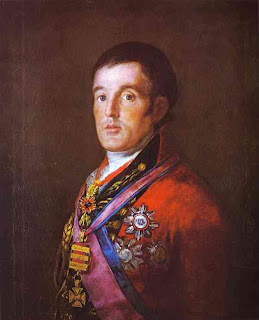In 1961, American oilman and Trustee of the Metropolitan Museum of Art Charles Wrightsman bought Goya’s “Portrait of the Duke of Wellington” for $392,000 from the Duke of Leeds and planned to take it stateside. Public outcry resulted in the painting being temporarily barred from export to the United States and two months later, the UK purchased the work from Wrightsman with the financial support of the Wolfson Foundation and the government. It proudly hung in London’s National Gallery for a scant three weeks before being stolen, with the thief apparently having gotten both in and out through an open bathroom window.
Because the painting had so recently been the subject of public furor, it’s theft quickly made it a cultural icon. In the first James Bond film, released in 1962, Sean Connery can be seen walking down an elegant staircase in the lair of the villainous Dr No when he spots Goya’s portrait of the Duke of Wellington and says, “So that’s where it went.”
Actually, no one knew where the painting had gone for several weeks, when finally a ransom note was delivered. The ransomer was able to identify marks visible only on the back of the painting, proving that it was in his possession. The ransomer, whose notes were theatrical and flamboyantly written, thought it outrageous that the British government would spend such a sum on a painting when retired British citizens had to pay to watch television. The Goya would be returned, wrote the ransomer, if a charitable fund of equivalent value, £140,000, were established to pay for television licenses for old age pensioners. There seemed to be no personal motivation for the theft, only outrage at the government’s TV license scheme.
The police refused to negotiate and a second ransom note was received and read:
Goya Com 3. The Duke is safe. His temperature cared for – his future uncertain. The painting is neither to be cloakroomed or kiosked, as such would defeat our purpose and leave us to ever open arrest. We want pardon or the right to leave the country – banishment? We ask that some nonconformist type of person with the fearless fortitude of a Montgomery start the fund for £140,000. No law can touch him. Propriety may frown – but God must smile.
Still the police would not respond and a third ransom letter followed:
Terms are same. . . . An amnesty in my case would not be out of order. The Yard are looking for a needle in a haystack, but they haven’t a clue where the haystack is. . . I am offering three-pennyworth of old Spanish firewood in exchange for 140,000 of human happiness. A real bargain compared to a near million for a scruffy piece of Italian cardboard.
The police held their ground and the case went cold until 1965, when a note arrived at the offices of the Daily Mirror newspaper along with a luggage check ticket for the Birmingham rail station. Checking the locker, the police found the stolen painting, which had been deposited by someone identifying himself as a “Mister Bloxham,” likely a reference to Oscar Wilde’s The Importance of Being Earnest, in which an infant is found in a handbag at a rail station luggage check. The painting had been recovered, handed over as a sign of good will by the thief, who realized that his demands, which he felt were entirely reasonable and noble, would not be met.
Rather than being a handsome and debonair art thief, the perpetrator turned out to be a middle aged, over weight, unemployed bus driver named Kempton Bunton, who gave himself up six weeks later and told police that he had planned to use the ransom money to buy TV licenses for the poor, serving three months in jail for his offense.
During the trial the jury only convicted Bunton of the theft of the frame (which was not returned). Since his defence successfully claimed that he never wanted to keep the painting, he was not convicted of stealing the portrait itself. Bunton was sentenced to 3 months in prison. A provision in the Theft Act 1968, where section 11 makes it illegal to remove without authority any object displayed or kept for display to the public in a building to which the public have access, was enacted as a direct result of this case.
Many people have doubts about Bunton’s involvement in the theft, particularly as the large sized man could hardly have slipped in and out of the NPG through a partially opened window. And it’s been said that documents released in 1996 by the National Gallery are said to reveal his possible innocence. The mystery surrounding the Duke of Wellington continues. One thing’s for certain – Goya’s portrait of the Duke hangs once more in the National Portrait Gallery where, one would hope, the loo windows are now kept locked.

Even when constructed of oil and canvas the dear Duke is quite the adventurer! Now if it goes missing again I fear I will have to suss out a few ladies of my acquaintance who are obsessed with all things Wellington!
This is not my favorite portrait of dear Artie. A similar one hangs in the National Gallery of Art in DC.
I read somewhere that Goya had been commissioned to paint Napoleon, but that he painted over that canvas and turned the painting into a portrait of Wellington.
Fabulous post. I love that he actually had an altruistic motive for stealing the painting.